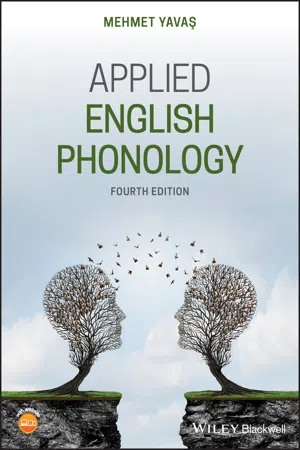
- English
- ePUB (mobile friendly)
- Available on iOS & Android
Applied English Phonology
About this book
The new edition of the leading textbook for English applied phonetics and phonology
A leading textbook for English Phonetics and Phonology, the fourth edition of Applied English Phonology is an accessible, authoritative introduction to the English sound system. Providing clear explanations and numerous illustrative examples, this new edition has been fully updated with the latest research and references. Detailed discussions of fundamental concepts of applied English phonology cover phonetic elements, phonemics, English consonants and vowels, stress and intonation, structural factors in second language phonology, and much more.
Designed for students and professionals in both theoretical and applied linguistics, education, and communication sciences and disorders, this textbook contains new material throughout, including a new chapter introducing typical phonological development, patterns of simplification, and disordered phonology. Expanded sections explore topics such as contracted forms, issues in consonant and vowel transcription conventions, and regional dialects of American English. The essential introduction to phonetics and phonology, this textbook:
- Presents new and revised exercises, references, and recommended readings
- Covers developmental disorders relevant to the field of speech pathology
- Includes end-of-chapter passages that help students check their phonetic transcriptions
- Features an enhanced companion website which contains instructor resources and sound files for transcription exercises
Written by an internationally recognized scholar and educator, Applied English Phonology, Fourth Edition is essential reading for anyone in applied phonetics and phonology courses, as well as students and practitioners in areas of language and linguistics, TESOL, and communication sciences and disorders.
Frequently asked questions
- Essential is ideal for learners and professionals who enjoy exploring a wide range of subjects. Access the Essential Library with 800,000+ trusted titles and best-sellers across business, personal growth, and the humanities. Includes unlimited reading time and Standard Read Aloud voice.
- Complete: Perfect for advanced learners and researchers needing full, unrestricted access. Unlock 1.4M+ books across hundreds of subjects, including academic and specialized titles. The Complete Plan also includes advanced features like Premium Read Aloud and Research Assistant.
Please note we cannot support devices running on iOS 13 and Android 7 or earlier. Learn more about using the app.
Information
1
Phonetics
1.1 Introduction
1.2 Phonetic Transcription
- The same sound is represented by different letters. ...
Table of contents
- Cover
- Table of Contents
- Preface to Fourth Edition
- Note to the Instructor
- About the Companion Website
- Abbreviations
- 1 Phonetics
- 2 Phonology
- 3 English Consonants
- 4 English Vowels
- 5 Acoustics of Vowels and Consonants
- 6 Syllables
- 7 Stress and Intonation
- 8 Phonology of L1
- 9 Structural Factors in Second Language Phonology
- 10 Spelling and Pronunciation
- Recommended Readings
- Appendix: List ofSound FilesAppendix: List ofSound Files
- Glossary
- References
- Index
- End User License Agreement